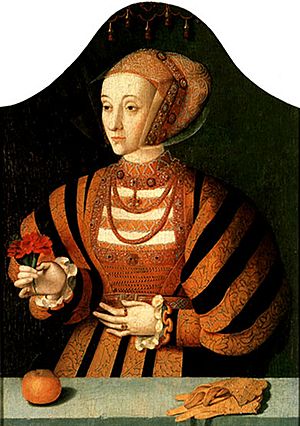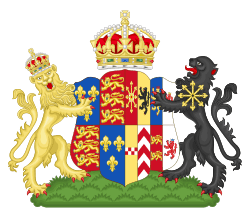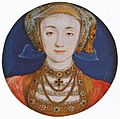Anne of Cleves facts for kids
Quick facts for kids Anne of Cleves |
|
|---|---|

Portrait by Hans Holbein the Younger, 1539
|
|
| Queen consort of England | |
| Tenure | 6 January 1540 – 12 July 1540 |
| Born | 28 June or 22 September 1515 Düsseldorf, Duchy of Berg, Kingdom of Germany, Holy Roman Empire |
| Died | 16 July 1557 (aged 41 or 42) Chelsea Manor, England |
| Burial | 3 August 1557 Westminster Abbey |
| Spouse | |
| House | La Marck |
| Father | John III, Duke of Cleves |
| Mother | Maria of Jülich-Berg |
| Signature | |
Anne of Cleves (born 1515, died 16 July 1557) was a Queen of England. She was the fourth wife of King Henry VIII. She was queen from January to July 1540.
Before she became queen, not much was known about her early life. In 1539, talks began for Anne to marry King Henry VIII. Henry wanted to make a political alliance with Anne's brother, William. William was a leader of Protestants in Western Germany. This alliance would help Henry against possible attacks from Catholic France and the Holy Roman Empire.
Anne arrived in England in December 1539 and married Henry in January 1540. But after six months, their marriage was ended. This meant she was never officially crowned queen. After the marriage ended, Henry gave her a lot of money and properties. She was then known as "the King's Beloved Sister." Anne stayed in England for the rest of her life. She lived to see the reigns of Edward VI and Mary I. She also lived longer than all of Henry's other wives.
Contents
Early Life of Anne of Cleves
Anne was born in 1515 in Düsseldorf. She was the second daughter of John III, who was the Duke of Cleves. Her mother was Maria, Duchess of Jülich-Berg. Anne grew up in Schloss Burg.
Anne's father was a moderate Protestant. He sided with the Schmalkaldic League, a group of Protestant states. This group was against Emperor Charles V. After her father died, Anne's brother William became Duke. Anne's older sister, Sibylle, married John Frederick. He was a leader of the Protestant Confederation in Germany.
In 1527, when Anne was 11, she was promised in marriage to Francis. He was the 9-year-old son of the Duke of Lorraine. But this promise was unofficial because of their young age. It was later cancelled in 1535. Anne's family was not strictly aligned with one religion. Her brother William was a Lutheran, but her mother was a strict Catholic.
The family had an ongoing disagreement with Charles V over Gelderland. This made them good allies for England's King Henry VIII. Henry's chief minister, Thomas Cromwell, strongly suggested the marriage with Anne.
Preparing for the Wedding

The famous artist Hans Holbein the Younger was sent to paint portraits of Anne. He also painted her younger sister, Amalia. Henry was considering both sisters as his fourth wife. He asked Holbein to paint them exactly as they were, without making them look better. These portraits are now in famous museums.
Talks for the marriage began in March 1539. Thomas Cromwell managed these discussions. A marriage agreement was signed in October of that year. The King agreed to pay a large sum of money to Anne's brother.
Henry liked women who were educated and cultured. Anne did not have much formal education. But she was good at needlework and enjoyed playing card games. She could read and write, but only in German. Still, Anne was seen as gentle, good, and easy to get along with. This made her seem like a good choice for Henry.
The French ambassador described Anne as tall and slim. He said she had "middling beauty" and a "resolute look." She had fair hair and was said to have a lovely face. An English writer, Edward Hall, said her hair was "fair, yellow and long." He also said she looked beautiful in English clothes. However, she seemed serious by English standards. She also looked older than her age. Holbein's portrait showed her with a high forehead and heavy-lidded eyes.
Henry met Anne privately on New Year's Day 1540. This happened at Rochester Abbey as she traveled to London. Henry and some of his friends went in disguise to where Anne was staying. They wanted to surprise her.
Henry was disappointed when he saw Anne. He felt she was not as beautiful as he had been told. Anne did not seem to notice him much, as she didn't know it was the King. Henry then showed her who he was. But he was already put off the marriage. Henry and Anne then met officially on January 3rd. This was at Blackheath, where a grand reception was held.
Many historians believe Henry's dislike for the marriage came from Anne's appearance. He felt misled because his advisors had praised her beauty. He complained, "She is nothing so fair as she hath been reported." Cromwell was blamed for the Holbein portrait. Henry thought it did not show Anne accurately. He also blamed Cromwell for the exaggerated reports of her beauty. When the King finally met Anne, he was reportedly shocked by her plain looks.
Henry asked Cromwell to find a way to avoid the marriage. But by this point, it was too late. Ending the marriage would harm the important alliance with the Germans. In his anger, the King turned against Cromwell.
The Marriage and Its End

Anne traveled from Düsseldorf to England. She was met by English merchants in Antwerp. Despite Henry's strong doubts, they were married on January 6, 1540. The wedding took place at the royal Palace of Placentia in Greenwich, London. Archbishop Thomas Cranmer performed the ceremony. Anne's wedding ring had the words "God send me well to keep" engraved on it. When she arrived in England, Anne quickly adopted the Catholic form of worship. Henry had kept this after his break with Rome.
In February 1540, Anne spoke positively about the King. She told the Countess of Rutland that he was a kind husband. She said he would kiss her goodnight and good morning. However, Henry did not seem to be attracted to his new queen.
Anne was told to leave the Court on June 24. On July 6, she learned that Henry wanted to end their marriage. Several courtiers and doctors gave statements. They confirmed the King's disappointment with her appearance.
Soon after, Anne was asked if she agreed to end the marriage. She said yes. Cromwell, who had pushed for the marriage, was later accused of treason. The marriage was officially ended on July 12, 1540.
| Family tree of the wives of Henry VIII | |||||||||||||||||||||||||||||||||||||||||||||||||||||||||||||||||||||||||||||||||||||||||||||||||||||||||||||||||||||||||||||||||||||||||||||||||||||||||||||||||||||||||||||||||||||||||||||||||||||||||||||||||||||||||||||||||||||||||||||||||||||||||||||||||||||||||||||||||||||||||||||||||||||||||||||||||||||||||||||||||||||||||||||||||||||||||||||||||||||||||||||||||||||||||||||||||||||||||||||||||||||||||||||||||||||||||||||||||||||||||||||||||||||||||||||||||||||||||||||||||||||||||||||||||||||||||||||||||||||||||||||||||||||||||||||||||||||||||||||||||||||||||||||||||||||||||||||||||||||||||||||||||||||||||||||||||||||||||||||||||||||||||||||||||||||||||||||||||||||||||||||||||||||||||||||||||||||||||||||||||||||||||||||||||||||||||||||||||||||||||||||||||||||||||||||||||||||||||||||||||||||||||||||||||||||||||||||||||||||||||||||||||||||||||||||||||||||||||||||||||||||||||||||||||||||||||||||||||||||||||||||||||||||||||||||||||||||||||||||||||||||||||||||||||||||||||||||||||||||||
|---|---|---|---|---|---|---|---|---|---|---|---|---|---|---|---|---|---|---|---|---|---|---|---|---|---|---|---|---|---|---|---|---|---|---|---|---|---|---|---|---|---|---|---|---|---|---|---|---|---|---|---|---|---|---|---|---|---|---|---|---|---|---|---|---|---|---|---|---|---|---|---|---|---|---|---|---|---|---|---|---|---|---|---|---|---|---|---|---|---|---|---|---|---|---|---|---|---|---|---|---|---|---|---|---|---|---|---|---|---|---|---|---|---|---|---|---|---|---|---|---|---|---|---|---|---|---|---|---|---|---|---|---|---|---|---|---|---|---|---|---|---|---|---|---|---|---|---|---|---|---|---|---|---|---|---|---|---|---|---|---|---|---|---|---|---|---|---|---|---|---|---|---|---|---|---|---|---|---|---|---|---|---|---|---|---|---|---|---|---|---|---|---|---|---|---|---|---|---|---|---|---|---|---|---|---|---|---|---|---|---|---|---|---|---|---|---|---|---|---|---|---|---|---|---|---|---|---|---|---|---|---|---|---|---|---|---|---|---|---|---|---|---|---|---|---|---|---|---|---|---|---|---|---|---|---|---|---|---|---|---|---|---|---|---|---|---|---|---|---|---|---|---|---|---|---|---|---|---|---|---|---|---|---|---|---|---|---|---|---|---|---|---|---|---|---|---|---|---|---|---|---|---|---|---|---|---|---|---|---|---|---|---|---|---|---|---|---|---|---|---|---|---|---|---|---|---|---|---|---|---|---|---|---|---|---|---|---|---|---|---|---|---|---|---|---|---|---|---|---|---|---|---|---|---|---|---|---|---|---|---|---|---|---|---|---|---|---|---|---|---|---|---|---|---|---|---|---|---|---|---|---|---|---|---|---|---|---|---|---|---|---|---|---|---|---|---|---|---|---|---|---|---|---|---|---|---|---|---|---|---|---|---|---|---|---|---|---|---|---|---|---|---|---|---|---|---|---|---|---|---|---|---|---|---|---|---|---|---|---|---|---|---|---|---|---|---|---|---|---|---|---|---|---|---|---|---|---|---|---|---|---|---|---|---|---|---|---|---|---|---|---|---|---|---|---|---|---|---|---|---|---|---|---|---|---|---|---|---|---|---|---|---|---|---|---|---|---|---|---|---|---|---|---|---|---|---|---|---|---|---|---|---|---|---|---|---|---|---|---|---|---|---|---|---|---|---|---|---|---|---|---|---|---|---|---|---|---|---|---|---|---|---|---|---|---|---|---|---|---|---|---|---|---|---|---|---|---|---|---|---|---|---|---|---|---|---|---|---|---|---|---|---|---|---|---|---|---|---|---|---|---|---|---|---|---|---|---|---|---|---|---|---|---|---|---|---|---|---|---|---|---|---|---|---|---|---|---|---|---|---|---|---|---|---|---|---|---|---|---|---|---|---|---|---|---|---|---|---|---|---|---|---|---|---|---|---|---|---|---|---|---|---|---|---|---|---|---|---|---|---|---|---|---|---|---|---|---|---|---|---|---|---|---|---|---|---|---|---|---|---|---|---|---|---|---|---|---|---|---|---|---|---|---|---|---|---|---|---|---|---|---|---|---|---|---|---|---|---|---|---|---|---|---|---|---|---|---|---|---|---|---|---|---|---|---|---|---|---|---|---|---|---|---|---|---|---|---|---|---|---|---|---|---|---|---|---|---|---|---|---|---|---|---|---|---|---|---|---|---|---|---|---|---|---|---|---|---|---|---|---|---|---|---|---|---|---|---|---|---|---|---|---|---|---|---|---|---|---|---|---|---|---|---|---|---|---|---|---|---|---|---|---|---|---|---|---|---|---|---|---|---|---|---|---|---|---|---|---|---|---|---|---|---|---|---|---|---|---|---|---|---|---|---|---|---|---|---|---|---|---|---|---|---|---|---|---|---|---|---|---|---|---|---|---|---|---|---|---|---|---|---|---|---|---|---|---|---|---|---|---|---|---|---|---|---|---|---|---|---|---|---|---|---|---|---|---|---|---|---|---|---|---|---|---|---|---|---|---|---|---|---|---|---|---|---|---|---|---|---|---|---|---|---|---|---|---|---|---|---|---|---|---|---|---|---|---|---|---|---|---|---|---|---|---|---|---|---|---|---|---|---|---|---|---|---|---|---|---|---|---|---|---|---|---|---|---|---|---|---|---|---|---|---|---|---|---|---|---|---|---|---|---|---|---|---|---|---|---|---|---|---|---|---|---|---|---|---|---|---|---|---|---|---|---|---|---|---|---|---|---|---|---|---|---|---|---|---|---|---|
|
King Henry VIII and all six of his wives were related through a common ancestor, King Edward I of England, as follows:
|
|||||||||||||||||||||||||||||||||||||||||||||||||||||||||||||||||||||||||||||||||||||||||||||||||||||||||||||||||||||||||||||||||||||||||||||||||||||||||||||||||||||||||||||||||||||||||||||||||||||||||||||||||||||||||||||||||||||||||||||||||||||||||||||||||||||||||||||||||||||||||||||||||||||||||||||||||||||||||||||||||||||||||||||||||||||||||||||||||||||||||||||||||||||||||||||||||||||||||||||||||||||||||||||||||||||||||||||||||||||||||||||||||||||||||||||||||||||||||||||||||||||||||||||||||||||||||||||||||||||||||||||||||||||||||||||||||||||||||||||||||||||||||||||||||||||||||||||||||||||||||||||||||||||||||||||||||||||||||||||||||||||||||||||||||||||||||||||||||||||||||||||||||||||||||||||||||||||||||||||||||||||||||||||||||||||||||||||||||||||||||||||||||||||||||||||||||||||||||||||||||||||||||||||||||||||||||||||||||||||||||||||||||||||||||||||||||||||||||||||||||||||||||||||||||||||||||||||||||||||||||||||||||||||||||||||||||||||||||||||||||||||||||||||||||||||||||||||||||||||||
Life After the Marriage Ended
Anne had been given lands in January 1540 to support her household. After her marriage ended, she received a very generous settlement. This included Richmond Palace and Hever Castle. Hever Castle had been the home of Henry's former in-laws, the Boleyns. Anne of Cleves House in Lewes, East Sussex, was another property she owned. She never lived there, though.
Henry and Anne became good friends. She was an honorary member of the King's family. She was called "the King's Beloved Sister." Henry often invited her to court. Because she did not fight the annulment, Henry decided she would have a higher rank than all other women in England. Only his wife and daughters would rank above her.
After Catherine Howard was executed, Anne and her brother asked Henry to marry Anne again. Henry quickly refused. Anne seemed to dislike Catherine Parr, Henry's sixth wife. She reportedly said, "Madam Parr is taking a great burden on herself."
In March 1547, Edward VI's Privy Council asked Anne to move. They wanted her to leave Bletchingley Palace, her usual home. She moved to Penshurst Place. They said Penshurst was closer to Hever and that Henry VIII had wanted this move.
On August 4, 1553, Anne wrote to Mary I. She congratulated Mary on her marriage to Philip of Spain. On September 28, 1553, Anne joined Mary I's procession. She walked with Mary and her sister Elizabeth from St James's Palace to Whitehall. Anne also took part in Mary I's coronation procession. She may have been at the coronation itself at Westminster Abbey. These were her last public appearances. Since the new queen was a strict Catholic, Anne changed her religion again. She became a Roman Catholic.
After a short return to royal favor, Anne lost it in 1554. This happened after Wyatt's rebellion. Some believed Anne was involved in a plot with Elizabeth. There is no proof that Anne was invited back to court after 1554. She lived a quiet life on her estates. Anne never left England after she arrived as the King's bride. Despite sometimes missing her home, Anne was generally happy in England. She was described as a "commendable lady," courteous, gentle, and generous to her servants.
Death of Anne of Cleves
When Anne's health began to fail, Mary allowed her to live at Chelsea Old Manor. Henry's last wife, Catherine Parr, had lived there after her remarriage. In July 1557, Anne wrote her last will. In it, she mentioned her brother, sister, and sister-in-law. She also mentioned the future Queen Elizabeth, the Duchess of Suffolk, and the Countess of Arundel. She left money to her servants. She asked Mary and Elizabeth to employ them in their households. Everyone who served her remembered her as a very generous and easy-going mistress.
Anne died at Chelsea Old Manor on July 16, 1557. The most likely cause of her death was cancer. She was buried in Westminster Abbey on August 3. Her tomb is somewhat hard to find. It is on the opposite side of Edward the Confessor's shrine.
Anne's epitaph in Westminster Abbey is in English. It simply says:
She was the last of Henry VIII's wives to die.
Fictional Portrayals
The role of Anne of Cleves has been played by:
- Elsa Lanchester in The Private Life of Henry VIII (1933).
- Elvi Hale in the 1971 TV series The Six Wives of Henry VIII.
- Pia Girard in the 2003 ITV series Henry VIII.
- Joss Stone in the Showtime TV series The Tudors.
- Rebecca Dyson-Smith in the BBC mini-series Six Wives with Lucy Worsley.
- Genesis Lynea in the musical Six.
Images for kids
See also
 In Spanish: Ana de Cléveris para niños
In Spanish: Ana de Cléveris para niños






